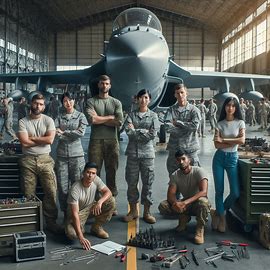
Introduction
Military aircraft maintenance is a critical but often overlooked aspect of modern air forces. While fighter jets, bombers, and transport planes capture headlines with their advanced technology and combat roles, the unsung heroes maintaining these machines ensure they remain safe, operational, and ready for missions. This article explores the comprehensive processes, challenges, and technologies involved in military aircraft maintenance, highlighting the skilled workforce and systems behind the scenes.
1. The Importance of Military Aircraft Maintenance
1.1 Ensuring Combat Readiness
Maintaining military aircraft is essential for combat readiness. Aircraft must be available at a moment’s notice, with all systems functioning flawlessly to ensure mission success and pilot safety. Maintenance schedules are rigorous and systematic to prevent any in-flight failures or mission delays.
Military maintenance teams focus on:
-
Routine inspections and servicing
-
Repair of damaged components
-
Updating avionics and software
-
Testing and quality assurance
1.2 Extending Aircraft Lifespan
Military jets and helicopters represent huge investments. Proper maintenance not only ensures safety but also extends the service life of the aircraft, sometimes by decades. This prolongs the value of the fleet and delays the need for costly replacements.
Maintenance strategies include:
-
Scheduled overhauls
-
Component life-cycle management
-
Corrosion control and structural repairs
2. Maintenance Categories and Procedures
2.1 Preventive and Corrective Maintenance
Maintenance falls into two broad categories: preventive and corrective.
Preventive maintenance involves routine inspections and servicing designed to prevent faults before they occur, such as lubrication, parts replacement, and system checks.
Corrective maintenance addresses unexpected faults or damage discovered during inspections or after missions, requiring repair or replacement of faulty parts.
2.2 Levels of Maintenance
Military maintenance is structured into multiple levels, each responsible for different tasks:
-
Organizational-level (O-Level): Basic inspections, servicing, and minor repairs performed on the flight line or hangar.
-
Intermediate-level (I-Level): More in-depth repairs, calibration, and component replacement, often requiring specialized tools and trained technicians.
-
Depot-level (D-Level): Comprehensive overhauls and refurbishments done at specialized facilities, sometimes involving complete disassembly and rebuilds.
3. Key Components of Military Aircraft Maintenance
3.1 Airframe Maintenance
The airframe is the structural backbone of an aircraft. Maintenance teams inspect for fatigue cracks, corrosion, and damage from combat or wear. Repairs involve patching or replacing skin panels, reinforcing structural members, and ensuring all control surfaces operate smoothly.
3.2 Engine and Propulsion Systems
Engines are among the most complex and sensitive components. Maintenance includes routine checks, cleaning, replacement of worn parts, and detailed diagnostics using advanced sensors. Jet engines undergo inspections for turbine blade wear, combustion efficiency, and fuel system integrity.
3.3 Avionics and Electrical Systems
Modern military aircraft rely heavily on avionics, including radar, communication, navigation, and weapon systems. Maintenance teams update software, replace faulty circuit boards, and calibrate sensors to ensure accurate and secure operations.
4. Tools, Technology, and Innovation in Maintenance
4.1 Diagnostic Tools and Predictive Maintenance
Modern aircraft maintenance uses advanced diagnostic tools such as ultrasonic testers, borescopes, and vibration analyzers. Predictive maintenance leverages sensor data and AI algorithms to forecast component failures before they happen, enabling timely interventions.
4.2 Robotics and Automation
Robotics are increasingly used for repetitive or dangerous tasks like painting, cleaning, or inspecting hard-to-reach areas. Automation improves precision, efficiency, and safety while reducing human error.
4.3 Maintenance Training and Simulation
Highly skilled technicians require continuous training to keep pace with advancing aircraft technology. Simulation systems train maintenance crews on virtual aircraft, troubleshooting, and repair procedures, ensuring readiness without grounding actual jets.
5. Challenges and Future Trends in Military Aircraft Maintenance
5.1 Dealing with Aging Fleets
Many air forces operate aging aircraft, requiring more frequent and complex maintenance. Finding replacement parts for older systems and integrating new technologies pose ongoing challenges.
5.2 Cybersecurity in Maintenance
With increasing digitalization, avionics maintenance now must consider cybersecurity. Protecting software updates and system diagnostics from hacking is critical for operational security.
5.3 Sustainability and Green Maintenance
Emerging trends include eco-friendly maintenance practices, such as reducing hazardous waste, recycling components, and using sustainable materials.
Conclusion: The Invisible Backbone of Air Power
Military aircraft maintenance is the invisible backbone of air power, ensuring fleets stay mission-ready and safe under extreme conditions. The expertise, innovation, and dedication behind the scenes make every flight possible.
What fascinates you most about military aircraft maintenance—the technology, the skill of the technicians, or the challenges of keeping aging fleets operational? Share your thoughts and join the conversation about this vital aspect of defense readiness.